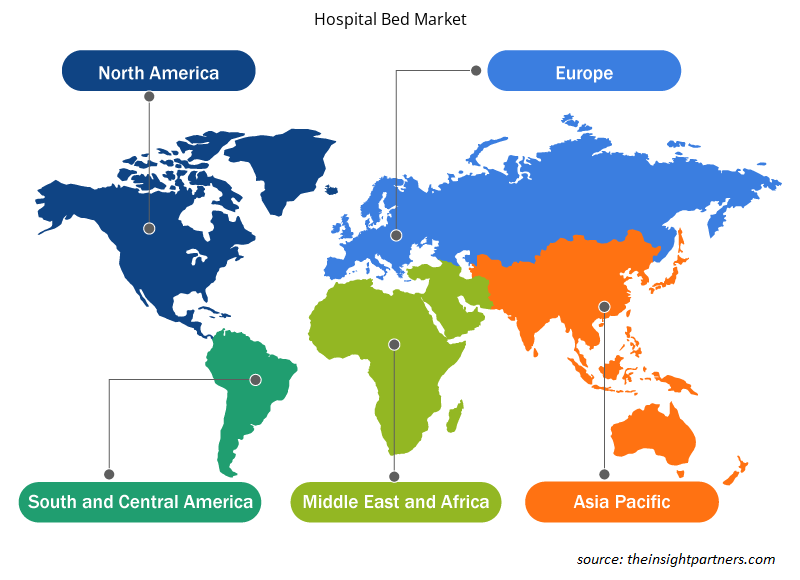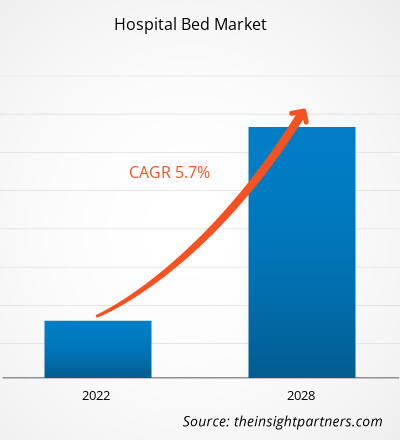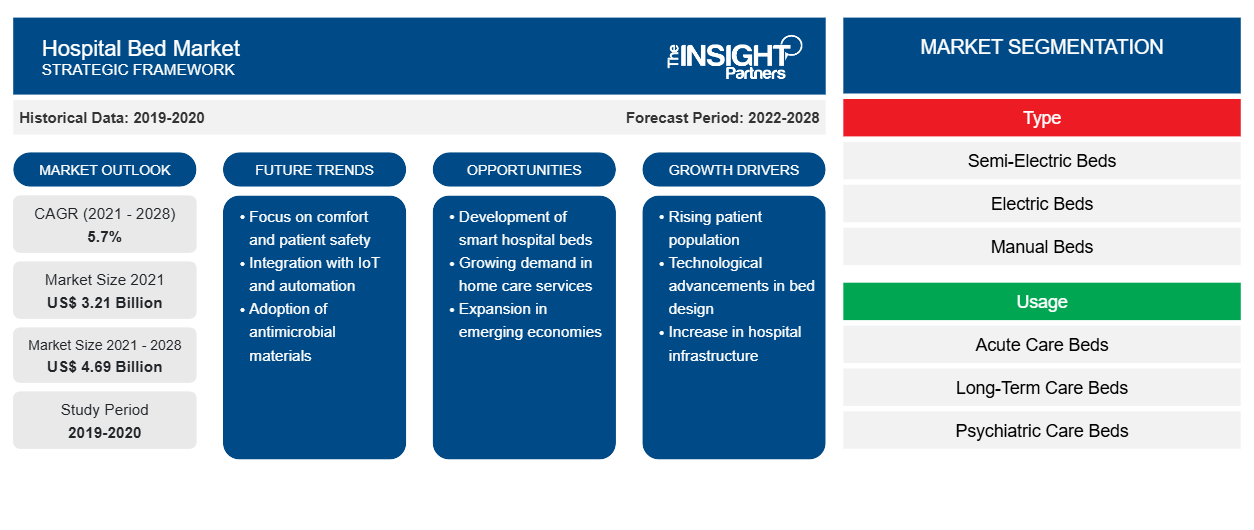Se espera que el mercado de camas de hospital crezca de US$ 3.214,96 millones en 2021 a US$ 4.688,96 millones en 2028; se estima que crecerá a una CAGR del 5,7% entre 2022 y 2028.
La creciente prevalencia de enfermedades crónicas y la creciente preferencia por camas de hospital altamente equipadas con características innovadoras están impulsando el crecimiento general del mercado. Además, los servicios de atención médica domiciliaria para la población geriátrica y los cuidados posoperatorios brindan oportunidades lucrativas a los actores del mercado.
Según el informe del Consejo Nacional de Salud, aproximadamente 40 millones de estadounidenses enfrentan limitaciones en sus actividades rutinarias debido a que padecen una o más afecciones crónicas de salud. Las enfermedades crónicas incurables afectan a aproximadamente 133 millones de estadounidenses, lo que representa más del 40% de la población total según el informe publicado en 2019. Muchas personas viven con una o más enfermedades crónicas, como diabetes, enfermedades cardíacas o depresión, pero con dos o más afecciones. Una prevalencia tan alta de enfermedades crónicas puede resultar en una mayor necesidad de hospitalización, lo que impulsa la demanda de camas de hospital. Según las estimaciones presentadas en un informe del Departamento de Salud e Infancia, aproximadamente el 80% de las consultas de médicos generales (GP) y el 60% de las necesidades de camas de hospital están relacionadas con casos de enfermedades crónicas con complicaciones asociadas. Según un informe de la Unidad de Datos y Salud Digital, hay camas de hospital de cuidados agudos disponibles para atención curativa, lo que representa 100.000 camas por población en Europa. Los pacientes se alojan en estas camas para gestionar el parto (obstetricia), curar enfermedades no mentales o proporcionar tratamientos definitivos a lesiones, realizar cirugías y aliviar los síntomas de enfermedades no mentales , entre otros. Aproximadamente el 75% del gasto sanitario se destina a la gestión de enfermedades crónicas cada año en los EE. UU. Según las estimaciones proporcionadas en el informe del Departamento de Salud e Infancia, aproximadamente 8 de las 11 principales causas de hospitalización en el Reino Unido están asociadas con enfermedades crónicas, y el 5% de los pacientes hospitalizados están relacionados con enfermedades de larga duración, ocupando aproximadamente el 42% de las camas de hospital.
La diabetes y las enfermedades cardíacas, entre otras afecciones crónicas, son las principales causas de muerte y discapacidad en los EE. UU. Por ejemplo, en 2019, la obesidad y la hipertensión arterial fueron las afecciones crónicas más comunes en California, que afectaron a más de uno de cada cuatro adultos en el estado. Además, las tasas de admisión hospitalaria fueron altas entre las personas que padecen afecciones crónicas, lo que representa 700 hospitalizaciones por cada 100.000 personas en California. Por lo tanto, la creciente prevalencia de enfermedades crónicas está favoreciendo el crecimiento general del mercado mundial de camas de hospital.
Personalice este informe según sus necesidades
Obtendrá personalización en cualquier informe, sin cargo, incluidas partes de este informe o análisis a nivel de país, paquete de datos de Excel, así como también grandes ofertas y descuentos para empresas emergentes y universidades.
-
Obtenga las principales tendencias clave del mercado de este informe.Esta muestra GRATUITA incluirá análisis de datos, desde tendencias del mercado hasta estimaciones y pronósticos.
Las úlceras por presión o llagas asociadas con las camas de hospital actúan como una importante restricción para el mercado de camas de hospital. Según un informe del NIH, la úlcera por decúbito es un problema común y grave entre los pacientes hospitalizados que permanecen en camas de hospital durante períodos prolongados . Por ejemplo, si un paciente está en modo sueño durante mucho tiempo y la presión de su peso corporal cruza un cierto punto, se producen hematomas y, en última instancia, heridas incurables. Por lo tanto, el personal del hospital tiene que rotar a estos pacientes en sus camas con regularidad para prevenir la formación de úlceras. Las llagas ocupan el tercer lugar entre los trastornos más costosos, después del cáncer y las enfermedades cardiovasculares a nivel mundial. Por ejemplo, según las estimaciones proporcionadas en el informe del NIH, las heridas por llagas afectan a más de 3 millones de adultos en todo el mundo. Además, los centros de cuidados agudos y rehabilitación a largo plazo luchan con los riesgos asociados con las llagas por presión entre los ingresos de pacientes hospitalizados. Por ejemplo, como se indica en el informe NursingHomeAbuseGuide.org , no menos de 150.000 pacientes o residentes en los EE. UU. experimentarán llagas por presión (en algunas etapas) en los próximos años.
Panorama regional
Europa tiene la mayor participación del mercado mundial de camas de hospital. Entre los Estados miembros de la UE, Alemania registra el mayor número de camas de hospital, con ingresos y crecimiento considerables. Datos recientes de la OCDE de 2020 confirman que Alemania tiene el mayor número de camas de UCI. Antes del inicio de la pandemia, Alemania tenía 28.000 camas de cuidados intensivos, es decir , más que la mayoría de sus países vecinos. Durante la primera ola de la pandemia de SARS-CoV-2 (a 18 de abril de 2020), 12.336 camas de UCI (o el 41% de la capacidad de camas de UCI disponibles) todavía estaban vacantes en el país. Para gestionar esta crisis sanitaria, el gobierno alemán hizo hincapié en la prevención primaria y secundaria, y se emprendió la adición de camas a la capacidad existente de la UCI como medida de prevención terciaria. El gobierno alemán añadió ~7.000 camas a 27 de abril de 2020. Se espera que el mercado de camas de hospital en el Reino Unido crezca con el creciente número de cirugías, incluidas las cirugías cardíacas, ortopédicas y traumatológicas.
Perspectivas basadas en tipos
Según el tipo, el mercado mundial de camas de hospital se segmenta en semieléctricas, eléctricas y manuales. Se estima que el segmento de camas eléctricas registrará la CAGR más alta entre 2022 y 2028. Las camas eléctricas están ganando terreno en el mercado. Estas camas también cuentan con una función de masaje terapéutico opcional para pacientes postrados en cama, gestionada por control remoto, que ayuda a la circulación y ayuda a prevenir las úlceras por decúbito y el dolor en las articulaciones. La función está habilitada como una característica incorporada en el colchón. Además, los cuidadores y los pacientes no necesitan realizar ajustes frecuentes ni preocuparse por perder el apoyo durante la noche. En agosto de 2022, el Hospital Hāwera compró 20 camas nuevas de la gama M9 de Howard Wright, que es un diseñador y fabricante de camas médicas con sede en Taranaki . Con la ayuda de estas camas, el personal del hospital podría hacer que los pacientes se sintieran más cómodos, eliminando la necesidad de levantarlos. Las camas M9 proporcionan controles eléctricos completos para sus ajustes a varias alturas y posiciones. Zenith9100, Invacare Full-Electric Homecare Bed y la gama DELTA 4 se encuentran entre otras camas de hospital eléctricas disponibles en el mercado.
Las empresas que operan en el mercado global de camas de hospital adoptan la estrategia de innovación de productos para satisfacer las cambiantes demandas de los clientes en todo el mundo, lo que también les permite mantener su marca en el mercado.
Perspectivas regionales del mercado de camas de hospital
Los analistas de Insight Partners explicaron en detalle las tendencias y los factores regionales que influyen en el mercado de camas de hospital durante el período de pronóstico. Esta sección también analiza los segmentos y la geografía del mercado de camas de hospital en América del Norte, Europa, Asia Pacífico, Oriente Medio y África, y América del Sur y Central.

- Obtenga datos regionales específicos para el mercado de camas de hospital
Alcance del informe sobre el mercado de camas de hospital
| Atributo del informe | Detalles |
|---|---|
| Tamaño del mercado en 2021 | US$ 3.21 mil millones |
| Tamaño del mercado en 2028 | 4.690 millones de dólares estadounidenses |
| CAGR global (2021-2028)CAGR (2021 - 2028) | 5,7% |
| Datos históricos | 2019-2020 |
| Período de pronóstico | 2022-2028 |
| Segmentos cubiertos |
Por tipo
|
| Regiones y países cubiertos |
América del norte
|
| Líderes del mercado y perfiles de empresas clave |
|
Densidad de actores del mercado de camas de hospital: comprensión de su impacto en la dinámica empresarial
El mercado de camas de hospital está creciendo rápidamente, impulsado por la creciente demanda de los usuarios finales debido a factores como la evolución de las preferencias de los consumidores, los avances tecnológicos y una mayor conciencia de los beneficios del producto. A medida que aumenta la demanda, las empresas amplían sus ofertas, innovan para satisfacer las necesidades de los consumidores y aprovechan las tendencias emergentes, lo que impulsa aún más el crecimiento del mercado.
La densidad de actores del mercado se refiere a la distribución de las empresas o firmas que operan dentro de un mercado o industria en particular. Indica cuántos competidores (actores del mercado) están presentes en un espacio de mercado determinado en relación con su tamaño o valor total de mercado.
Las principales empresas que operan en el mercado de camas de hospital son:
- Hill-Rom Holdings, Inc. (Baxter)
- Stryker
- Arjo
- Corporación Invacare
- CAMA PARAMOUNT CO., LTD.
Descargo de responsabilidad : Las empresas enumeradas anteriormente no están clasificadas en ningún orden particular.

- Obtenga una descripción general de los principales actores clave del mercado de camas de hospital
Segmentación del mercado mundial de camas de hospital
Según el tipo, el mercado mundial de camas de hospital se segmenta en camas semieléctricas, camas eléctricas y camas manuales. El segmento de camas semieléctricas representó la mayor participación de mercado en 2021. Sin embargo, el segmento de camas eléctricas representa el registro de la CAGR más alta de 2022 a 2028. Según el uso, el mercado mundial de camas de hospital se divide en camas de cuidados agudos, camas de cuidados a largo plazo, camas de cuidados psiquiátricos y otros. El segmento de camas de cuidados agudos lideró el mercado en 2021 y se espera que mantenga su dominio durante el período de pronóstico. Según la aplicación, el mercado mundial de camas de hospital se bifurca en camas de cuidados no intensivos y camas de cuidados intensivos. El segmento de camas de cuidados no intensivos lideró el mercado en 2021 y se espera que mantenga su dominio durante el período de pronóstico. Según el usuario final, el mercado se divide en hospitales y clínicas, centros de atención a personas mayores, centros quirúrgicos ambulatorios y entornos de atención domiciliaria. Según la geografía, el mercado mundial de camas de hospital está segmentado principalmente en América del Norte, Europa, Asia Pacífico, Medio Oriente y África, y América del Sur y Central.
Perfiles de empresas
- Hill-Rom Holdings, Inc. (Baxter)
- Stryker
- Arjo
- Corporación Invacare
- CAMA PARAMOUNT CO., LTD.
- Productos de salud GF, Inc.
- Malvestio SpA
- Span America (Corporación Savaria)
- Industrias Savion
- Empresa Stiegelmever GmbH & Co. KG.
- Medstrom
- Análisis histórico (2 años), año base, pronóstico (7 años) con CAGR
- Análisis PEST y FODA
- Tamaño del mercado, valor/volumen: global, regional y nacional
- Industria y panorama competitivo
- Conjunto de datos de Excel
Informes recientes
Informes relacionados
Testimonios
Razón para comprar
- Toma de decisiones informada
- Comprensión de la dinámica del mercado
- Análisis competitivo
- Información sobre clientes
- Pronósticos del mercado
- Mitigación de riesgos
- Planificación estratégica
- Justificación de la inversión
- Identificación de mercados emergentes
- Mejora de las estrategias de marketing
- Impulso de la eficiencia operativa
- Alineación con las tendencias regulatorias























 Obtenga una muestra gratuita para - Mercado de camas de hospital
Obtenga una muestra gratuita para - Mercado de camas de hospital